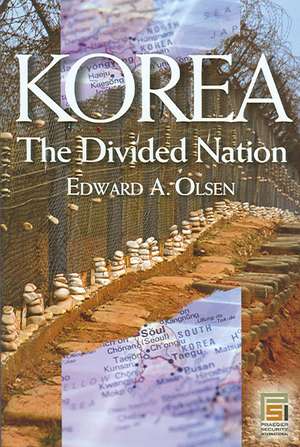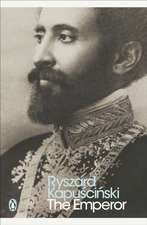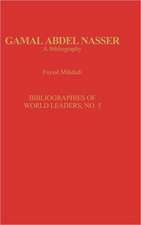Korea, the Divided Nation: Praeger Security International
Autor Edward Olsenen Limba Engleză Hardback – 29 sep 2005 – vârsta până la 17 ani
Din seria Praeger Security International
- 18%
 Preț: 334.19 lei
Preț: 334.19 lei - 8%
 Preț: 335.53 lei
Preț: 335.53 lei - 34%
 Preț: 376.10 lei
Preț: 376.10 lei - 46%
 Preț: 443.64 lei
Preț: 443.64 lei - 29%
 Preț: 240.11 lei
Preț: 240.11 lei - 8%
 Preț: 304.56 lei
Preț: 304.56 lei - 34%
 Preț: 373.82 lei
Preț: 373.82 lei - 19%
 Preț: 412.79 lei
Preț: 412.79 lei - 19%
 Preț: 338.42 lei
Preț: 338.42 lei - 18%
 Preț: 335.62 lei
Preț: 335.62 lei - 27%
 Preț: 377.35 lei
Preț: 377.35 lei - 27%
 Preț: 376.75 lei
Preț: 376.75 lei - 18%
 Preț: 336.46 lei
Preț: 336.46 lei - 18%
 Preț: 321.73 lei
Preț: 321.73 lei - 27%
 Preț: 384.51 lei
Preț: 384.51 lei - 18%
 Preț: 320.50 lei
Preț: 320.50 lei - 18%
 Preț: 320.50 lei
Preț: 320.50 lei - 18%
 Preț: 321.35 lei
Preț: 321.35 lei - 24%
 Preț: 420.54 lei
Preț: 420.54 lei - 14%
 Preț: 335.99 lei
Preț: 335.99 lei - 18%
 Preț: 355.82 lei
Preț: 355.82 lei - 18%
 Preț: 319.83 lei
Preț: 319.83 lei - 18%
 Preț: 334.28 lei
Preț: 334.28 lei - 32%
 Preț: 354.48 lei
Preț: 354.48 lei - 14%
 Preț: 335.14 lei
Preț: 335.14 lei - 38%
 Preț: 405.98 lei
Preț: 405.98 lei - 40%
 Preț: 571.34 lei
Preț: 571.34 lei - 18%
 Preț: 321.85 lei
Preț: 321.85 lei - 18%
 Preț: 323.25 lei
Preț: 323.25 lei - 18%
 Preț: 253.28 lei
Preț: 253.28 lei - 40%
 Preț: 571.50 lei
Preț: 571.50 lei - 14%
 Preț: 333.72 lei
Preț: 333.72 lei - 18%
 Preț: 301.73 lei
Preț: 301.73 lei - 19%
 Preț: 352.96 lei
Preț: 352.96 lei - 26%
 Preț: 387.80 lei
Preț: 387.80 lei - 18%
 Preț: 302.77 lei
Preț: 302.77 lei - 14%
 Preț: 333.91 lei
Preț: 333.91 lei - 17%
 Preț: 325.80 lei
Preț: 325.80 lei - 24%
 Preț: 338.58 lei
Preț: 338.58 lei - 34%
 Preț: 414.73 lei
Preț: 414.73 lei - 18%
 Preț: 354.30 lei
Preț: 354.30 lei - 29%
 Preț: 254.29 lei
Preț: 254.29 lei - 18%
 Preț: 354.11 lei
Preț: 354.11 lei - 18%
 Preț: 334.38 lei
Preț: 334.38 lei - 14%
 Preț: 302.68 lei
Preț: 302.68 lei - 18%
 Preț: 322.97 lei
Preț: 322.97 lei - 27%
 Preț: 376.50 lei
Preț: 376.50 lei - 27%
 Preț: 322.81 lei
Preț: 322.81 lei - 27%
 Preț: 382.91 lei
Preț: 382.91 lei - 18%
 Preț: 320.87 lei
Preț: 320.87 lei
Preț: 354.30 lei
Preț vechi: 433.80 lei
-18% Nou
Puncte Express: 531
Preț estimativ în valută:
67.80€ • 70.05$ • 56.43£
67.80€ • 70.05$ • 56.43£
Carte tipărită la comandă
Livrare economică 25 martie-08 aprilie
Preluare comenzi: 021 569.72.76
Specificații
ISBN-13: 9780275983079
ISBN-10: 0275983072
Pagini: 200
Dimensiuni: 156 x 235 x 20 mm
Greutate: 0.44 kg
Ediția:New.
Editura: Bloomsbury Publishing
Colecția Praeger
Seria Praeger Security International
Locul publicării:New York, United States
ISBN-10: 0275983072
Pagini: 200
Dimensiuni: 156 x 235 x 20 mm
Greutate: 0.44 kg
Ediția:New.
Editura: Bloomsbury Publishing
Colecția Praeger
Seria Praeger Security International
Locul publicării:New York, United States
Notă biografică
Edward A. Olsen is Professor of National Security Affairs and Asian Studies at the U.S. Naval Postgraduate School in Monterey, California. Prior to joining the faculty there, he was a political analyst on Korea and Japan at the U.S. Department of State, Bureau of Intelligence and Research.
Cuprins
Introduction and The Geographical SettingThe Legacy of AntiquityThe Imperial AgeLiberation and DivisionSouth Korea's Evolution (1948-2004)North Korea's Evolution (1948-2004)Two Korea's, International PerspectivesReuniting the Korean NationConclusion: United Korea's ProspectsNotes
Recenzii
Beginning with the earliest history of the Korean people, Olsen undertakes a succinct but remarkably thorough overview of Korea's unique history and culture prior to the 20th century. He also lays the political and social foundations for the calamitous century just passed, in which the once-overlooked Korean nation was the focus of colonial and later geopolitical rivalries between Japan, China, the US, and the USSR. Written in a style accessible to undergraduates, this brief volume is most suitable for readers with little or no knowledge about the Korean peninsula, particularly its history before the 1950-53 conflict. Recommended. General and undergraduate libraries seeking to add to their collection of general interest titles on East Asian history and politics.
[Clear and straightforward in its tone.
[A]dresses separately the political histories and foreign policies of both Koreas since 1948; his treatment of the last quater century of South Korean presidential politics, in particular, stands out as one of the best short synopses available. The analyses of the trilateral dynamics between the two Koreas and other major regional powers, considered in turn, and of likely paths that reunification might take, are likewise insightful. Although it is not the last book on the origins of Korea's contemporary situation, for many audiences, Olsen's brief account would work well as the first.
[Clear and straightforward in its tone.
[A]dresses separately the political histories and foreign policies of both Koreas since 1948; his treatment of the last quater century of South Korean presidential politics, in particular, stands out as one of the best short synopses available. The analyses of the trilateral dynamics between the two Koreas and other major regional powers, considered in turn, and of likely paths that reunification might take, are likewise insightful. Although it is not the last book on the origins of Korea's contemporary situation, for many audiences, Olsen's brief account would work well as the first.















